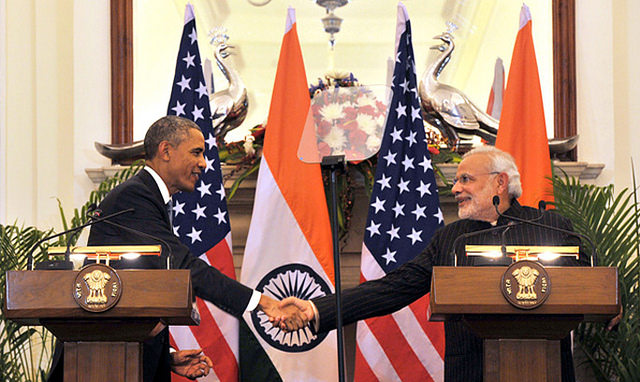 US President Barack Obama visited India between 25 and 27 January, becoming the first US president to visit India twice while in office and the first US president to be the Chief Guest during India’s Republic Day celebrations. In a visit high on symbolism, substance could easily have been lost. But in the official engagements that spanned this visit, India and the US moved much closer to achieving the kind of cooperation that’s repeatedly eluded them in the last decade. While the personal chemistry between the two leaders seemed to be the driving force behind reinvigorated cooperation, shared national interests underpinned that chemistry. Even the joint statement issued at the end of the bilateral dialogue reflected that with its title Shared Effort; Progress for All.
US President Barack Obama visited India between 25 and 27 January, becoming the first US president to visit India twice while in office and the first US president to be the Chief Guest during India’s Republic Day celebrations. In a visit high on symbolism, substance could easily have been lost. But in the official engagements that spanned this visit, India and the US moved much closer to achieving the kind of cooperation that’s repeatedly eluded them in the last decade. While the personal chemistry between the two leaders seemed to be the driving force behind reinvigorated cooperation, shared national interests underpinned that chemistry. Even the joint statement issued at the end of the bilateral dialogue reflected that with its title Shared Effort; Progress for All.
The present Indian government enjoys a substantial majority in the lower house of parliament and Prime Minister Narendra Modi has articulated a clear vision of development. US analysts have hailed what they see as a predictable environment for investment, and the revision of India’s land and labour laws by the Modi government should help to make investments in India even more attractive.
India’s economic progress will be accelerated by greater foreign investment from—and technological cooperation with—the developed world. And the US needs newer markets as China settles for lower growth rates as it adjusts its economic structure. Those big geopolitical and geoeconomic drivers are likely the reason why the Indian Prime Minister overcame the bitter history of the denial of a visa by the US for his alleged role during the 2002 riots to visit the US a few months after assuming office. A lot of agreements achieved in principle during Modi’s September visit to the US were translated into more practical cooperation in or on the eve of Obama’s visit to India. The ‘Smart Cities’ initiative was turned into Memorandums of Understanding as was the agreement on improving the hygiene, water and sanitation conditions in urban India.
Moreover the leaders appear to have broken the deadlock on the two issues that’ve impeded closer civil nuclear cooperation—the US’ worry about the Indian Civil Nuclear Liability Bill that made suppliers as liable as operators in the event of an accident, and India’s worry about the sovereignty implications of the tracking clause attached to US nuclear fuel supply. Finer details are awaited, but overcoming those hurdles should facilitate and accelerate nuclear technology cooperation between India and host of other countries, including Australia.
On defence cooperation, both sides agreed to expand the Defence Technology and Trade Initiative (DTTI) to allow co-development and co-production in four pathfinder areas, and a joint group was announced to look into jet-engine and aircraft-carrier technology sharing and design. Both sides also agreed to expand their naval engagement, joint exercises, military personnel exchanges and defence dialogues under the 2015 Framework for the US–India Defence Relationship.
Has China driven the recent warmth in US–India relations? In part. It’s important to recall that Prime Minister Modi gave an exuberant welcome to President Xi Jinping in September 2014. It was for the first time that a visiting dignitary had been received outside New Delhi and a lot of preparation went into President Xi’s visit as he came to India with an ambitious agenda. But at the same time as President Xi was enjoying the Indian hospitality, another border standoff erupted and on this occasion the Chinese Army was regarded as highly aggressive. Perhaps the duality of India–China engagement didn’t go down well in Delhi; India, being the smaller power of the two, is not in a mood to be coaxed into economic cooperation without strategic certainty.
At the same time, there’s an inherent bilateral logic to the US–India relationship. India will never be a US ally because strategic autonomy has been and will remain a cornerstone of its global approach. But the shared interests are many, including Afghanistan’s future, terrorist havens in Pakistan, the advent of Islamic State, and freedom of navigation across Asia. In the time between bilateral state visits, India and the US have come to realise that working towards practical deliverables is the only way to expand cooperation and mutual understanding.
Avinash Godbole is a research assistant with the Institute for Defence Studies and Analyses in New Delhi. These are his personal opinions. Image courtesy of Flickr user narendramodiofficial.

